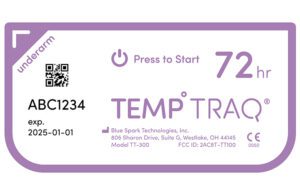
Blue Spark’s TempTraq continuous temperature monitoring patch could one day be used for fever prediction. The patch is 100mm long, 50mm wide, 3mm thick and weighs 5.1 grams. [Photo courtesy of Blue Spark Technologies]
Blue Spark Technologies developed the first wireless continuous temperature monitor patch, TempTraq, to enable faster fever detection than standard manual readings every four hours.
Westlake, Ohio-based Blue Spark is now looking at fever prediction rather than just detecting them.
The R&D team is working on developing an AI neural network model built on the company’s collection of continuous temperature data captured in the cloud, CEO John Gannon said in an interview.
“Taking our existing data, training an AI model to be able to understand and learn what fever profiles and onsets of fevers look like, and then apply that to new patients … we are working toward an FDA filing around that,” he said. “If we can identify fever, for example, an hour before it happens, that’s a meaningful amount of time in the medical world to be able to impact the outcome of that patient. Our goal is to be able to give that information to the clinician so that they can act.”

Blue Spark CEO John Gannon [Photo courtesy of Blue Spark Technologies]
Blue Spark is also looking into additional sensors to monitor more vital signs than just temperature, building off the company’s printed battery and experience with flexible electronics.
“Our idea would be having a form factor that might be more advantageous for clinicians and patients,” Gannon said.
The company raised $40 million this spring to fund R&D efforts and expand its sales and marketing functions. Ghost Tree Partners led the investment.
“Blue Spark has leading-edge technology backed by clinical research and results,” Ghost Tree Partners Managing Partner Mark Fox said in a news release at the time. “We are excited to support the company’s next phase of growth and accelerate the company’s innovative patient monitoring solutions to healthcare and life-sciences providers worldwide.”
Developing, designing and manufacturing the TempTraq patch
A thin, flexible carbon-zinc printed battery is the proprietary technology that powers the single-use TempTraq patch as it takes 8,600 temperature measurements per day.
But power supply wasn’t the most difficult challenge. The first version of the device would be worn in the armpit for up to 24 hours, and Blue Spark needed a solution that would stick.

Matt Ream, Blue Spark’s EVP of marketing and innovation [Photo courtesy of Blue Spark Technologies]
“I’m an electrical engineer. I helped design the antennas and the Bluetooth radios,” said Matt Ream, Blue Spark’s EVP of marketing and innovation. “The toughest thing to get right on this was the adhesive because we’re cleared for all ages, anywhere from infants to elderly people with very thin skin. You want it to stay on, but you don’t want it to take your skin off.”
RELATED: Wearable devices and fragile skin: How to select the right adhesive
Ream said they found the solution through “a little bit of trial and error and fate.” Seeking guidance in the early days, they worked with medical device subcontractors on some of the initial builds. The development team wanted an adhesive that would be comfortable for patients, sticky enough for use and meet ISO 10993 compliance for cytotoxicity, sensitization and skin irritation per FDA regulations.
“We started off with some acrylics initially that we were told we’re gentle. Their definition of gentle and our definition of gentle were a little bit different,” Ream said. “To give you an idea, one of those adhesives is now a structural adhesive form for us. It was a skin-rated medical grade adhesive, but it was very strong.”
The development team tested the adhesives on themselves and others. “We have some members of our family that don’t talk to us anymore,” Ream joked.
As Blue Spark launched the product at the International Consumer Electronics Show in 2015, they still weren’t convinced they had the right adhesive for the job.
“There was an adhesive manufacturer that was exhibiting there because it was the wearable section of the show and they figured there’s got to be a lot of people looking to stick their devices onto people,” Ream said. “I came across them and explained my issue to them. And they’re like, ‘Here, try some of these.’ It took off from there.”
The solution was a silicone gel adhesive that holds firmly, releases gently and can be reapplied. (Ream declined to name the specific adhesive product or the manufacturer.)
The Class II medical device was first FDA 510(k)-cleared in September 2015. The new adhesive was among the updates cleared in 2020 by the FDA in TempTraq’s next FDA 510(k) submission, which also included a longer wear time of up to 72 hours and software updates.
At the end of our interview, Gannon wanted to share some advice that he was given about using contract manufacturers to work out the production kinks on a new device before bringing manufacturing in-house.
“For about the first two and a half years, we used contract manufacturers to help us do the production ahead of doing our actual build-out of our own manufacturing facility, so you don’t end up investing in something and then have to invest again and again while you get it right. It gives you the opportunity to iterate and once you finally have it mastered, then put your manufacturing facility in place,” he said. “We now do all the manufacturing on-site, but I think it was good advice that we got early on not to do that right out of the gate.”